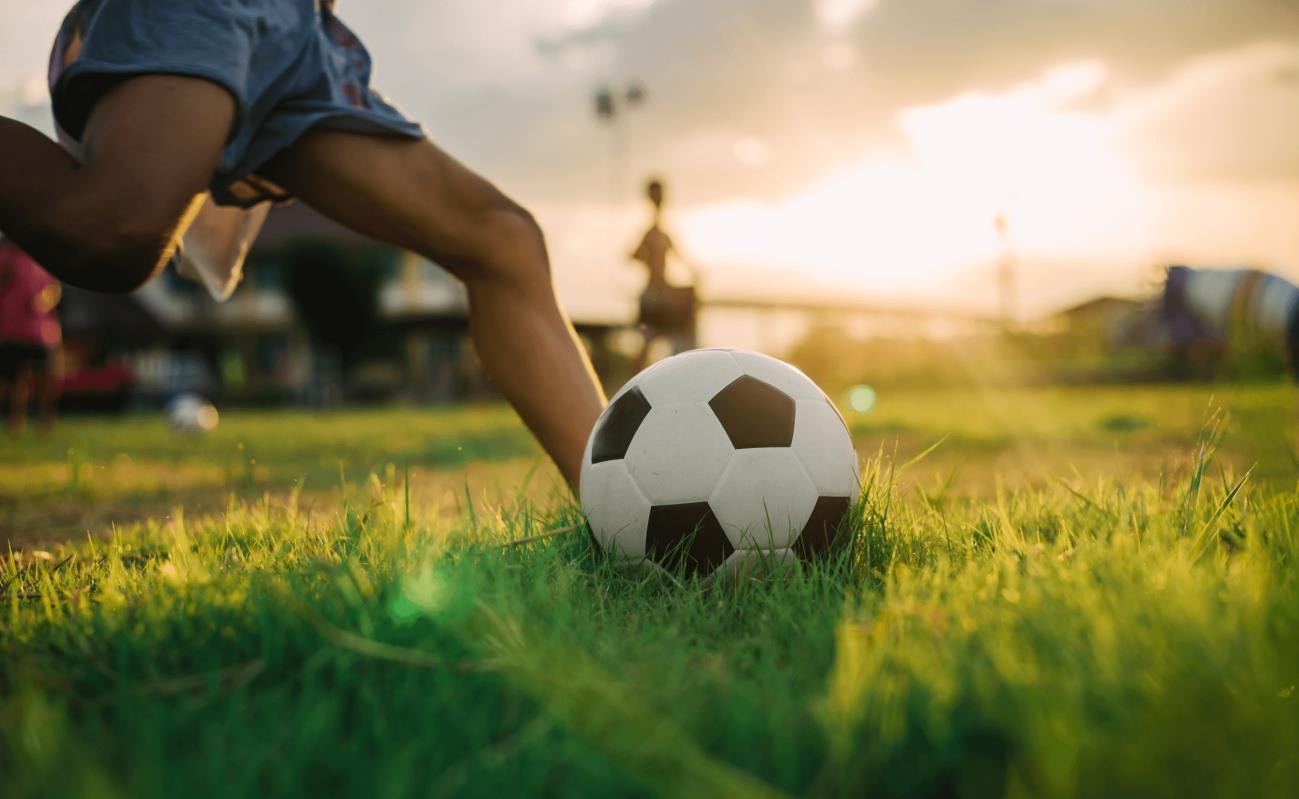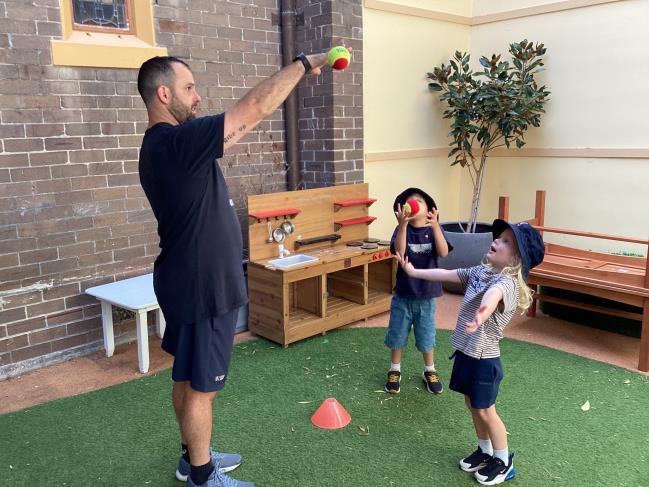Reddam ELS Woollahra

Dear Parents and Caregivers,

The voices of the children form an ever-present soundtrack to the life of the ELS, whether in the chatter between each other while at play, or when singing in Music lessons, or putting on their most animated acting voices in Drama, or cheering each other on at Sports. However, there are other moments when those voices are silenced, as their attention becomes entirely focused on one thing – stories.
Storytelling is a powerful tool in an early learning environment that provides countless benefits for young children. It is a way to engage children's imaginations, promote language development, and teach important lessons and values.
Storytelling is an effective way to develop language and literacy skills. Listening to stories helps children to develop vocabulary, grammar, and syntax, and teaches them how to use language effectively. When children hear stories, they learn to recognise different speech sounds and understand how to put them together to form words and sentences. This foundation is critical for later literacy development, including reading and writing.
In addition to language development, storytelling is an excellent way to build comprehension skills. When children listen to stories, they must use their imaginations to visualise the events and characters, and understand the sequence of events. This process helps children to develop their comprehension skills, which are essential for understanding and interpreting information in many subject areas.

Of course, storytelling is also an excellent way to engage children's imaginations. When children listen to stories, they enter a world of imagination and creativity. They can imagine themselves as characters in the story, and explore new worlds and ideas. This imaginative play is essential for children's cognitive development and helps them learn how to think creatively and solve problems. It is no wonder that young children frequently request the same story to be read over and over.
Finally, storytelling is a way to build strong relationships between children and adults. When adults read stories to children, they are providing a nurturing and supportive environment. This can help children to develop a sense of security and trust, which is essential for healthy emotional development. Stories also allow us the opportunity to interact with our children and to enjoy stories together, as we ask and answer questions, enjoy the characters and immerse ourselves in the moment.
Have a great weekend!
Dee Pitcairn PrincipalHappy Birthday
Reddam House ELS would like to wish a very Happy Birthday to Christian Capuanu
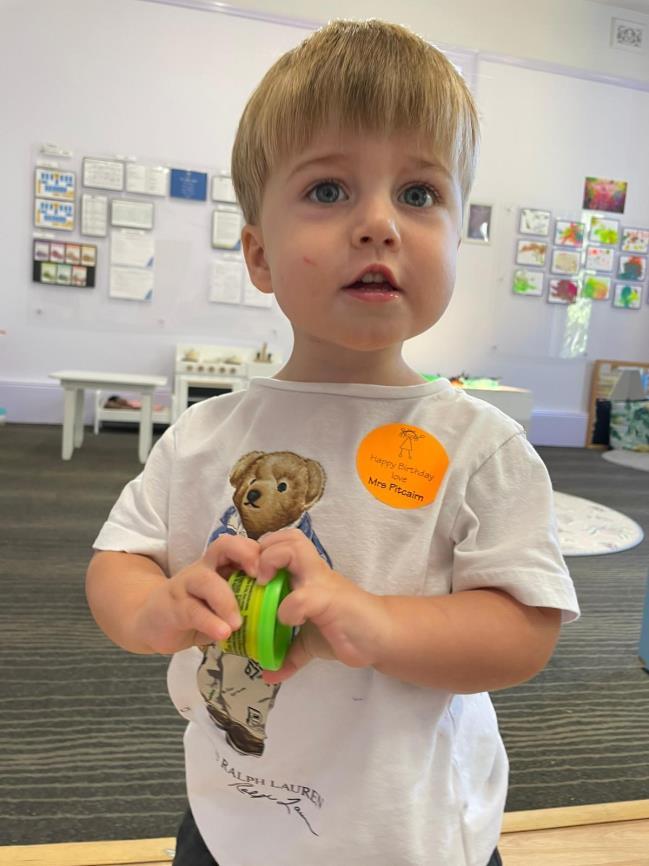
Alexander Lin
Alice Kashaba

Nest
This week we had some fabulous, sunny days, so we spent most of our mornings in the playground. The children put on their sunhats and sunscreen and went out to the big playground. They showed lovely cooperative play together, taking turns, running and chasing friends and teachers. What a wonderful time we had in the playground and the happy energy that the sunshine evokes was certainly evident.
Collecting nature encourages children to observe with all their senses. Children can learn to focus their attention and take in the details of things around them. It can also be a peaceful, reflective experience for children. With every new texture, sensation, and item discovered, children are building an understanding of the world around them.
This activity allows children to explore their creativity and imagination freely. They are able to explore the patterns of nature as they transfer them onto paper with glue while creating shapes and pictures with no restrictions or expectations.
Painting with flowers and leaves is a gorgeous and engaging craft, providing the children with the opportunity to look at nature’s offerings differently, while provoking creative thought and conversations amongst teachers and peers.




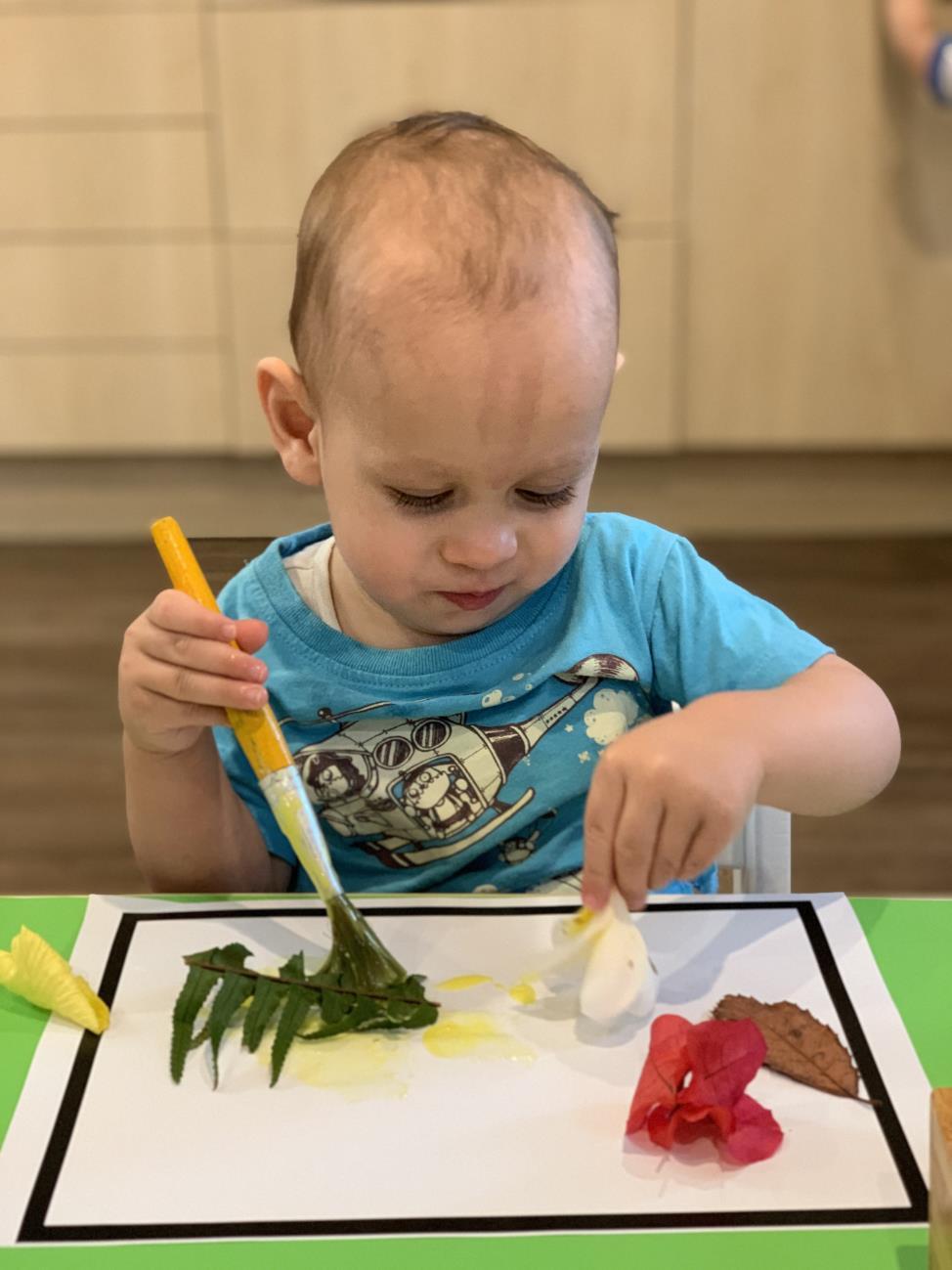




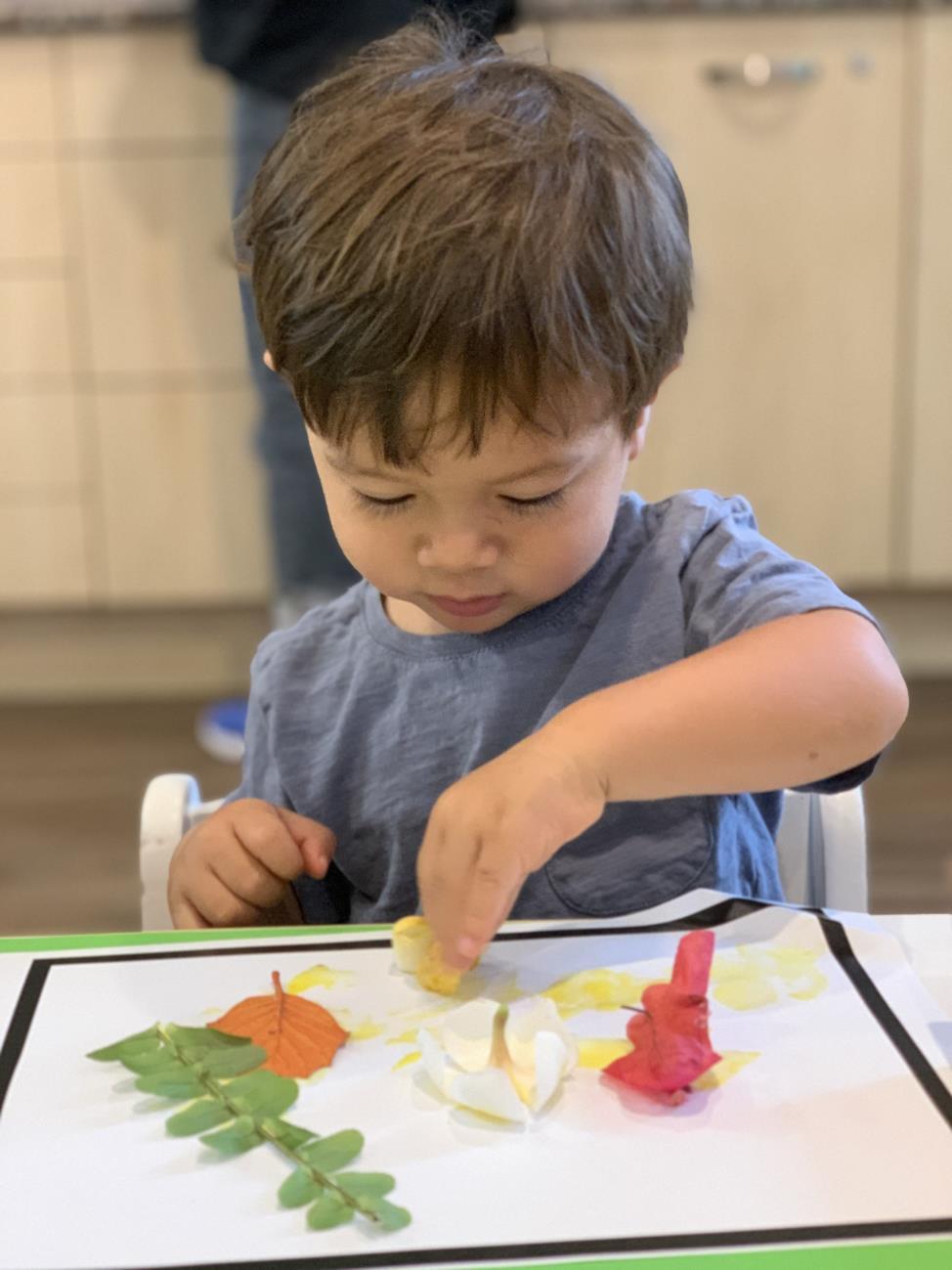

Fledglings
Safari Animals
Lately in the Fledglings, we have been celebrating nature and the beautiful ocean animals, as this has become a great interest within our group. Extending this learning journey in the world of animals, this week the children explored more about safari animals, through the book “The Lion sleeps tonight” by Solomon Linda, Luigi Creatore, Hugo Peretti and George David Weiss. In both attendance groups, some of our children love talking about elephants and lions.

We took this opportunity to explore more about these animals, by learning about the place where they live, what they like eating and the noises they make. We watched videos of these animals in their natural habitat, which caused a lot of excitement in our group. The children kept on pointing at the animals on the screen, showing to their peers and teachers what they could see.
Through these experiences, the children were developing knowledge about the natural world around them and learning about nature and the difference between wild and domesticated animals. It supported children to develop their communication skills as they engaged in conversations and learned new words. Pretending to be an animal by moving or walking like one helps children to develop body awareness, gross motor skills and it can also help with self-regulation.
Vygotsky believed that young children are curious and actively involved in their own learning and the discovery and development of new understandings. According to Vygotsky (1978), social interaction plays a fundamental role in the development of cognitive skills. He believed much important learning by the child occurs through social interaction with a knowledgeable adult.
In the Mini Atelier, the children got busy creating a lion mask, by sticking yellow and orange stripes around paper plates. They used these masks in the dramatic play area to pretend to be lions themselves. Still in the Mini Atelier, the children made their Elmer - the elephant - by decorating the shape of the elephant with coloured dot markers. These collaborative experiences encouraged the children to work together, sharing spaces and tools, while mediated by the teachers.
Celebrating animals has been a great way to engage the children in lots of small conversations, supporting their efforts to develop their vocabulary and discover new facts about each animal.
Early Years Learning Framework, V2.0, 2022:
OUTCOME 2: Children are connected with and contribute to their world, they become socially responsible and show respect for the environment.
OUTCOME 3: Children have a strong sense of wellbeing, they become strong in their physical learning and mental wellbeing.
Outcome 4: Children are confident and involved learners, resourcing their own learning through connecting with people, place, technologies, and natural and processed materials.
OUTCOME 5: Children are effective communicators, when they use digital technologies and media to access information, investigate ideas and represent their thinking.






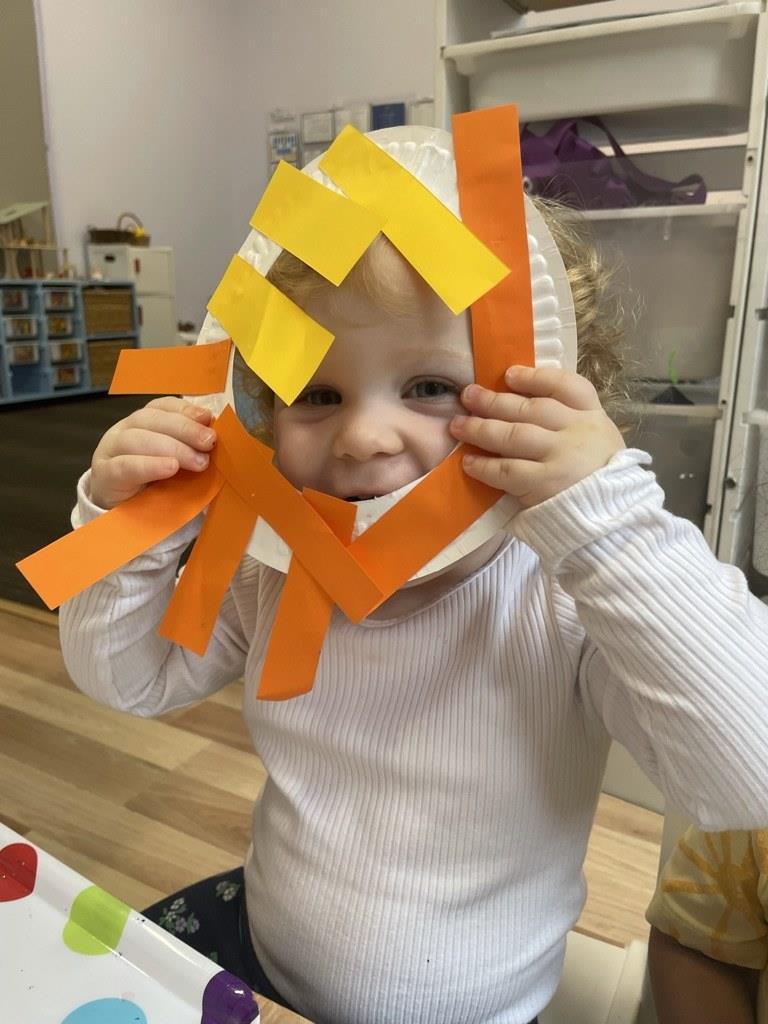



At Stage 2 we would like to embrace the many celebrations of different cultures and events. It's a great opportunity to teach our children about different traditions and customs from around the world, while also enjoying some festive activities together. This week we celebrated St Patrick’s Day. This holiday is celebrated in Ireland and many other countries around the world on the 17th of March. St. Patrick was a missionary who lived in Ireland in the 5th century. He is known for spreading Christianity throughout the country, and is credited with using the shamrock to explain the concept of the Holy Trinity to the Irish people. The holiday has evolved into a celebration of Irish culture with parades, special foods, music, dancing, party and a lot of green!
We read a book called “St Patrick’s Day - Irish Traditions and History” to start our learning journey, where we looked at many symbols that represent this special day, such as the shamrocks, rainbow, harps and leprechauns. At the atelier this week, the children were invited to create the national emblem of Ireland, a shamrock, by using a capsicum cut in half and different shades of green paint. Our children started to have the discussion about the different shades of green that we used, and how we can make the colour lighter with adding different amount of white paint. We also talked about the pot of gold which leprechauns leave at the end of the rainbow and all the colours found in a rainbow, before we sang the rainbow song. We created the rainbows and clouds with coloured paper and paper plates to show where leprechauns can be found.
At our sensory table, we dyed rice and pastas in green, and our children were encouraged to make a green necklace or bracelet by threading with the pasta, or collecting the gold coin or other St Patrick’s Day symbols in the rice. Sensory play allows children to gain confidence and involvement in learning by using all the different senses. Piaget believed that young children need to be able to see, touch, taste, smell, move and hear the thing they are learning about. This is called “concrete learning”. Sensory play allows children to broaden their concentration, creativity and social skill by participating in small group play.
On Friday, we invited all our children to dress in green, and we had a great dancing party with Irish music. St. Patrick's Day is an enjoyable and light-hearted holiday that celebrates Irish culture.







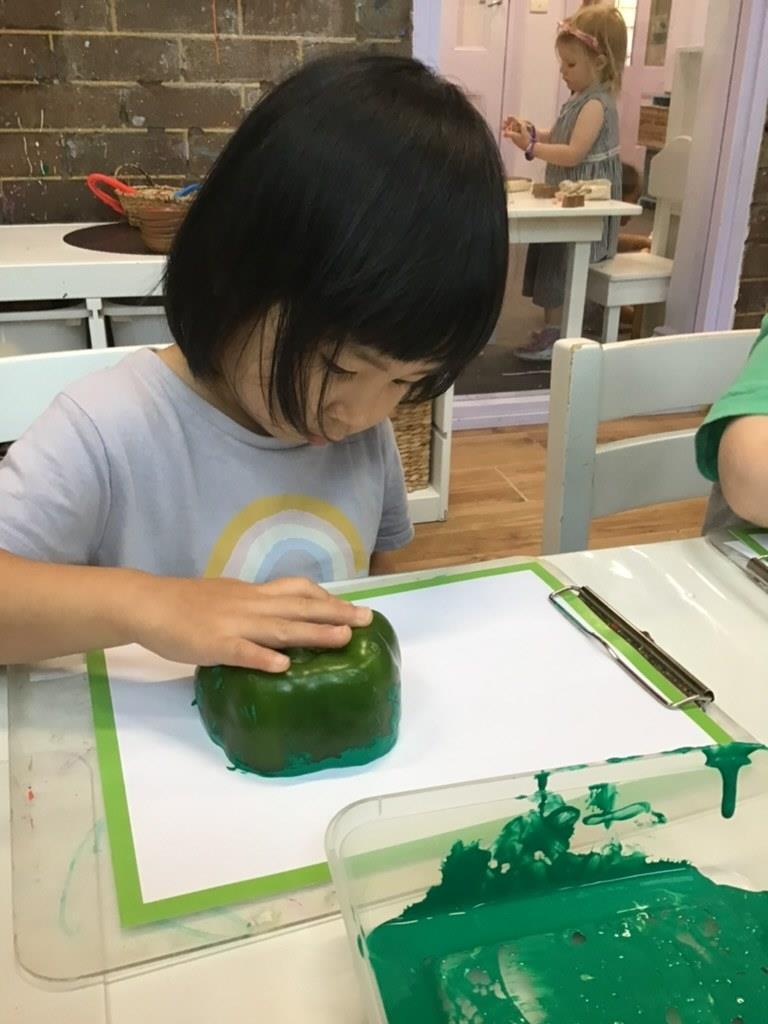
Stage 3
My world, your world – This is me
In the Stage 3R classroom the families were asked to send in photos and share something about their life in their family and what the children like to do. Each child was then asked to come and share this with the class, while proudly sitting in front of their friends in our meeting place (the carpet mat). The children discovered that they like to do many things which are similar to those their friends enjoy, such as going to the beach, playing in the park, and visiting the zoo. Lots of our families have pets (mostly dogs) at home and we found out their names including the names of Lily-Mei’s unusual pets, three alpacas. We also discovered that everyone loves to celebrate many of the same occasions especially Lunar New Year, birthdays, Easter and Christmas. This type of experience gives children an opportunity to stand up in front of their friends and speak about a topic that is of interest to them or to share something that they love. It builds confidence and helps children to develop effective communication skills.
To follow this up we created self-portraits. This is a great way to support children's self-concept and identity, as well as creativity and fine motor skills. One of the ideas of exploring portraits of any kind is to provide a point of interest or stimuli for the child to look deeper at the subject, to notice and observe finer points and details. Then to transform that through their own lens, onto paper. When the children are invited to create self-portraits, we offer them mirrors and encourage long, sustained study of their faces from this unfamiliar perspective. The children are encouraged to identify their own facial features in their reflection, interpret their positioning and replicate this on paper. A self-portrait is an intimate, bold declaration of identity. In a self-portrait, the child offers themselves as both subject and artist. When we look at a self-portrait, we see a child as they see themselves.
During the early years, it is important to focus on the process of creative drawing, and not on the product. There is no need to formally teach children to draw. The best way to teach them is to give them exposure to materials and drawing tools and let them express themselves freely. As they grow and mature, their drawings will become more detailed and reflect the world around them. The first drawing of a person usually emerges around 3 or 4 years of age. These ‘tadpole’ people are drawn with just a head and usually legs directly attached to the head.
For our self-portraits the children observed their facial features in the three-way mirror where they drew their initial portrait. We then moved on to the easel area where they were asked to draw themselves again and then use paint to continue to express themselves through art. This is something we will revisit again each term as we continue to develop our skills.
Children use art to express their imagination and interests. Through their creations, children construct meaning in many ways which in turn connects to the EYLF Learning Outcome 1. Children have a strong sense of identity. 1.3 – Children develop knowledgeable and confident self-identities. EYLF Learning Outcome 4 – Children are confident and involved learners. 4.3 Children transfer and adapt what they have learned from one context to another. Learning Outcome 5 - Children Are Effective Communicators
5.3 - Children express ideas and make meaning using a range of media.







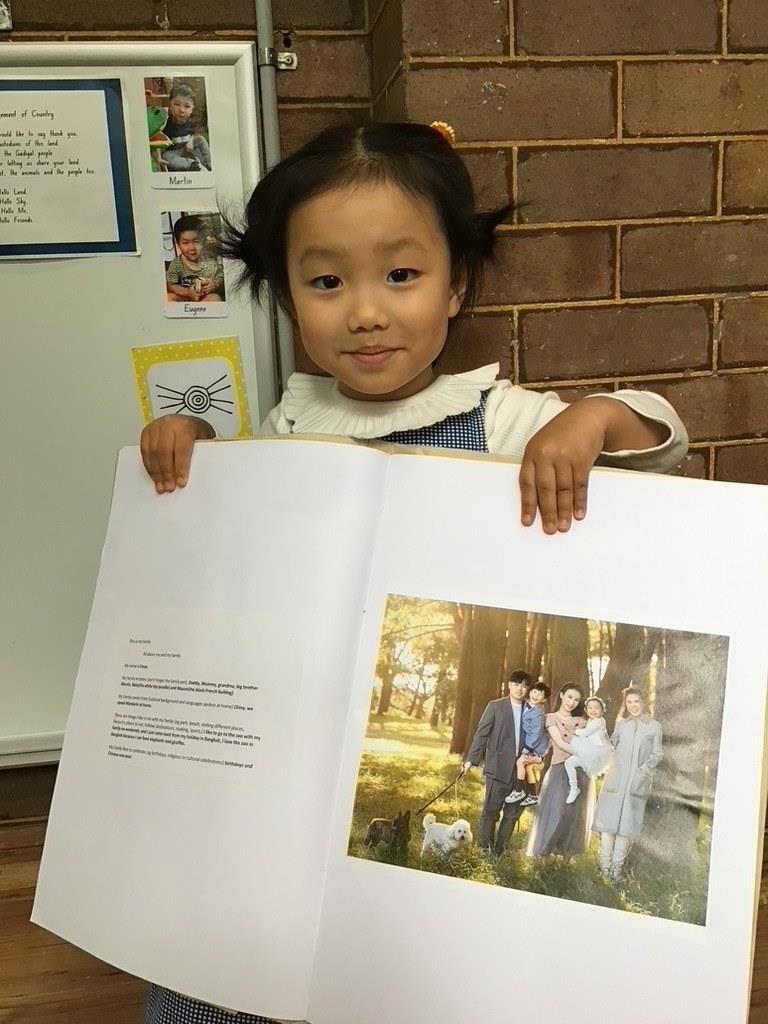

Stage 4
As we continue to explore our 4E provocation, “Knowing Me, Knowing You”, we have engaged in a variety of getting to know you experiences and sharing special memories with our friends and teachers. This time, it was teacher Sandra and Marley’s turn to share their celebration, ‘St Patrick’s Day’. Marley is about to embark on a trip back to Dad’s homeland Ireland for Easter, so the excitement is raising.
Our first experience was our “rainbow treading art project on canvas. Threading engages the ‘pincer grip’ finger motion, which strengths the fine motor development. This action is similar to holding a pencil to draw, write, do up buttons, tie shoelaces or open lunch boxes. We have enjoyed listening to stories about the cheeky leprechauns. To extend the children’s interest in leprechauns, they were invited to complete a cut and stick leprechaun alongside their own interpretation of the little Irish fellow inspired by the stories we have been reading. They added colour and design by using a variety of materials.

Our Monday-Wednesday children were keen to join in the festivities, even though they were away on the dress up day itself. To avoid disappointment, we had a pre-party on Wednesday so that everyone felt included. During our Wednesday celebrations Sandra introduced us to the Irish tin whistle, along with her music book she used at school, when she was little Sandra, in Ireland. We danced to the Irish jig, we swirled around with scarfs and played music instruments.
The children were asked what they knew about St Patrick’s Day?
Below are the children’s comments:
Marley: It’s leprechaun day, it’s my favourite day, it’s green day. My dad is from Ireland. He likes to wear black. I will ask him to wear green on Friday.
Gabriel: Leprechauns are little persons who like putting gold on the rainbow. We eat green foods on St Patrick’s Day like pear, avocado dip, sea lettuce and cucumber and beans and green capsicum.

Jack: You dress up as green, I am going to wear black.
Georgia: You can go to Ireland. I have been before it is so chilly and with snow.
Eliza: You can wear green. It is cold in Ireland. You can wear a woolly jumper. I can eat chocolate in Ireland too. Santa will be there.
Jack: We wear green and look for Leprechauns.
Esther: It is Marley’s day, and she is my friend.
‘Educators who are culturally competent respect multiple ways of knowing, seeing, and living, celebrate the benefits of diversity and have an ability to understand and honour differences’ (EYLF, 2009, p16).








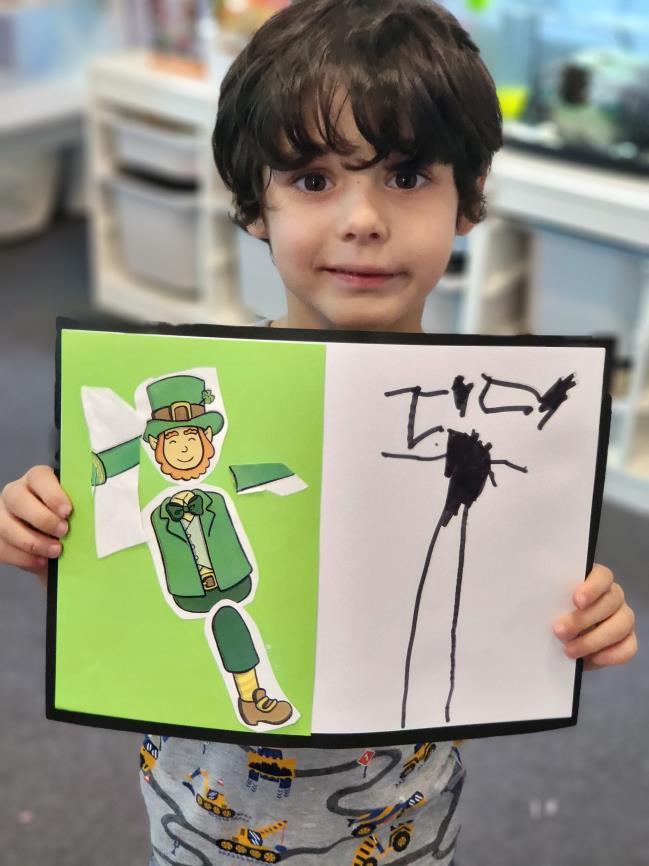








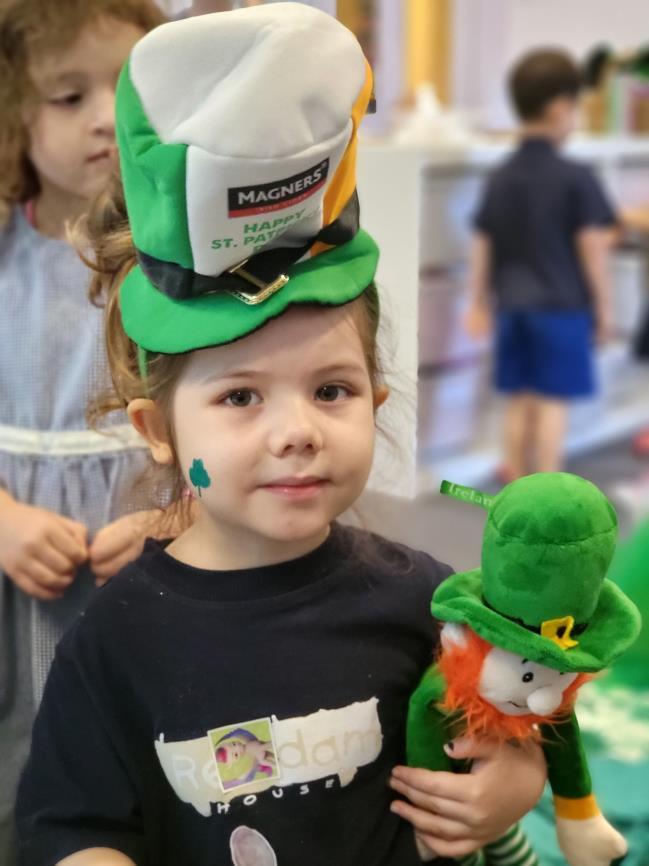


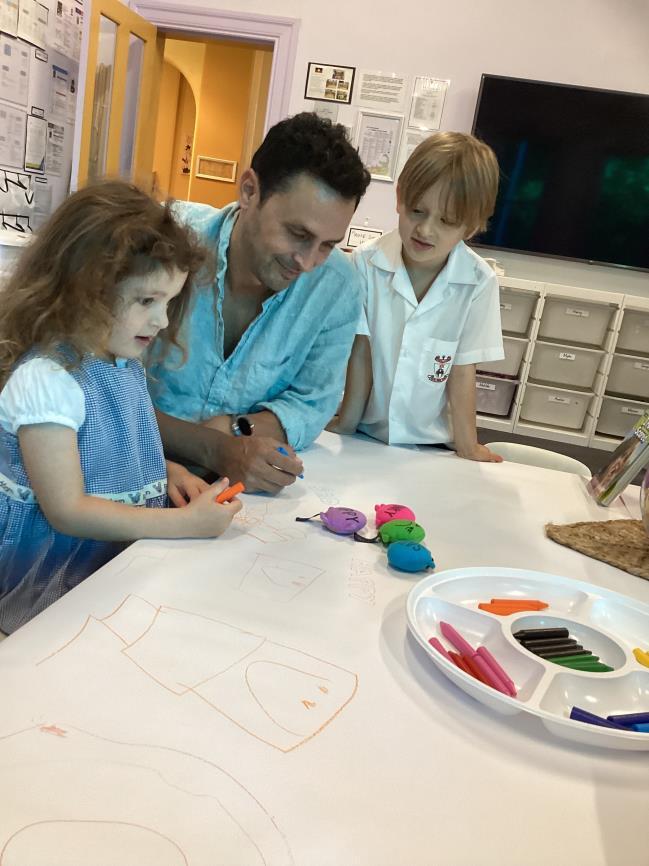

In Stages 3 and 4 we opened the lesson with our breathing exercise of ‘Fireworks’, as we celebrated St Patrick’s Day, which took place today.
To warm up our voices we sang over varied scales from descending, to thirds, to our usual penta-scale, to some simple animal sounds which the children had to guess – dog, cat and monkey. We sang through our "Good Morning Song" and our sing-a-longs - "ABC", "Kookaburra" and "Walking Walking". Using our scarves and maracas, we focused on building our coordination with alternate shaking and working on getting them moving in time, before we then layered the exercises with our stomping feet.
We revisited our building blocks and our new 'Caterpillar' sound which represents semi-quavers. Using what we’ve been learning, we built the rhythm of the melody to a new song "Who's That?". We first read the rhythm using the blocks; then with body percussion, we slapped the rhythm on our knees, before adding in words and music.
The musical alphabet is MUCH shorter than the regular alphabet. We looked at what letters are in the musical alphabet, reading them forwards from ‘A – G’ and backwards before finding them on the Piano Mat. Stage 3 found and stomped on their letter, while Stage 4 had to find their letter and stomp 'DOGCAT - DOG - CAT'.
In Stage 2 and The Fledglings we opened our lesson with our action song ‘Wheels on the Bus’, getting our bodies moving using our scarves as our wipers, opening doors and motor. We warmed up our voices with our weekly scales and counting before moving into our sing-a-longs. Keeping our scarves with

maracas, we danced and shook along with “ABCs” and “Kookaburra Sits in the Old Gumtree” – testing our listening in “ABCs” by adding in our freezes.
Still using our maracas, we sang “I’m A Little Scarecrow”, while working on our balance and scaring away any birds coming into our garden! We sang and moved to “Walking Walking”, helping our motor movement and following the instructions of the music – from walking; jumping; hopping; flying and going backwards.
This week we used our imaginations to act out the animals on “Old MacDonald’s Farm”. We thought about what animals we could find on the farm, and what sounds they would make, from mooing cows, to clucking chickens and oinking pigs. To end the lesson, we used our castanets to click in time to some simple counting before closing with “Twinkle Twinkle” .
Down in The Nest we began the lesson with our scarves and singing “Wheels on the Bus” – one of Frankie’s favourites. We used our maracas for our morning sing-a-longs, and encouraged our babies to use two maracas and shake with both hands – Florence and Noah were even inspired to get up and start dancing!
With our maracas in hand, we got our legs moving like the little ants in “Ants Go Marching” – this week we had so many friends up and marching. It is great to see them growing in confidence. We used our castanets to click along to “Twinkle Twinkle” and “Bingo The Dog”, while really trying to work on that fine motor movement.
To end the lesson we had some free play on our instruments and the Piano Play Mat, as we encouraged our friends to walk or crawl across the keys.


